How do I hang a TV on the wall?
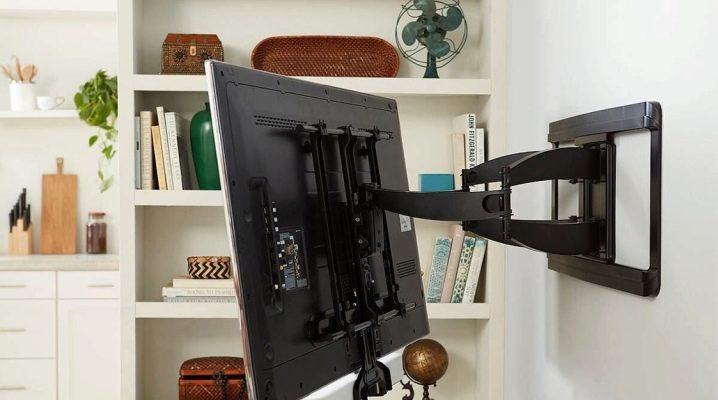
Knowing how to hang a TV on the wall is very important for a wide variety of categories of TV owners. Let's figure out how to properly mount 49-inch TVs and other sizes. You also need to pay attention to the features of installation on walls made of aerated concrete and foam blocks, from other materials.

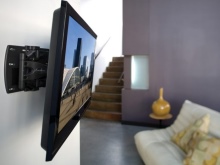
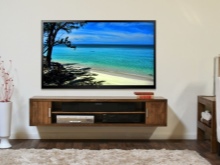
Pros and cons of installation
It is not enough just to buy a TV set - it is also important to place it properly. But it is not very reasonable to install it on a regular stand, on a regular cabinet or on a table. Any push - and an unsecured expensive device flies to the floor. If you fix the TV on the wall, then the problem is solved. It’s not that accidental shocks are not terrible, it will require special efforts, even if someone decides to deliberately damage the equipment.
Wall installation usually means mounting the TV exactly opposite the place from where it is going to be watched. This is the most comfortable and practical solution, both emotionally and physiologically. Almost any flat panel model can be wall-hung. Even if the mounts are not included in the delivery set, it will not be difficult to purchase them additionally.
Saving space, the absence of the need to buy any supports, and the increased aesthetics of the wall arrangement can be considered an important advantage.
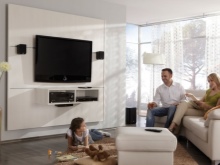
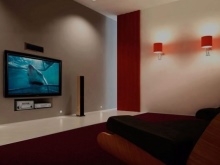
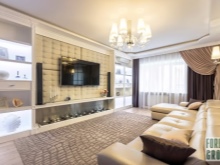
It should be borne in mind that it is more difficult to install the TV on a wall than on a stand. If you cannot drill the necessary holes yourself, you will have to pay for the services of third-party installers. And you have to resort to these services quite often. Especially if the TV is very heavy and large. The wall mount has also been criticized for:
- the likelihood of making mistakes;
- the need to strengthen the mount where vibration may appear;
- Difficulty accessing the back of the TV
- the need to mount stands for additional equipment (set-top boxes, players, consoles);
- the fact that the outlet will have to be transferred to the TV, or the TV should be placed strictly near the outlet;
- difficulties with fitting the cable into the interior.
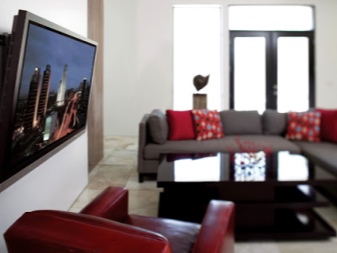

How high should you hang?
The main thing here is to avoid extremes. Placing the TV near the ceiling or in the upper third of the wall is simply inconvenient. You will have to constantly strain your neck, and this is unhealthy and can even lead to dizziness, muscle spasms. However, putting the TV close to the floor is also not good - an unnatural posture and, again, discomfort, which gradually harms health. Therefore, it is better to look for some kind of average placement, focusing on generally accepted standards.
Be sure to take into account the features of the device itself. Rounded panels do not adhere well to the wall, as the rounded corners can protrude. It is possible to hang flat equipment almost always and at any height.
The norms for the distance to spectators in the bedroom and in the hall, as well as in the offices, are always completely the same, because they are determined by the medical side of the issue. The calculation is usually done by multiplying the resolution factor by the diagonal.
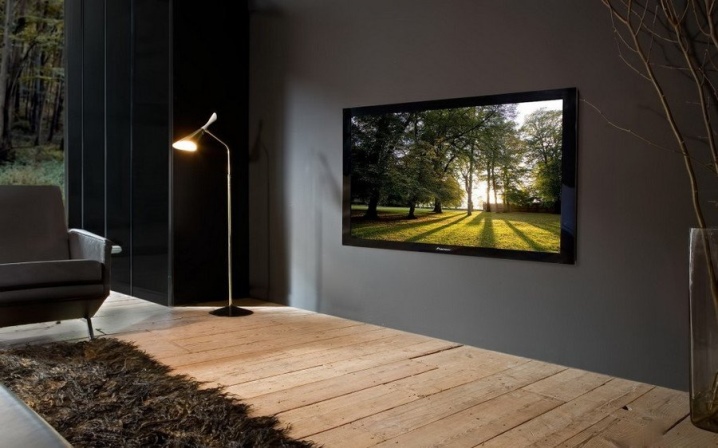
The height of the TV installation is calculated on a conditional straight line extending from the viewer's eyes. At the same time, they choose not only a good location, but also an attractive pose.From a medical point of view, the optimal height between the floor and the bottom edge of the screen is considered to be 75 cm. Any large TV set should be placed at a distance of 175 cm from the user.
It is optimal if the center point of the screen is at the eye level of the observer. But it is not located in the geometric center, but at 1/3 of the bottom line. The height of the furniture will also have to be taken into account. If you look at the screen from different points, take the average height, taking into account the seated spectators. It is advisable to hang even a large TV set at a height of at least 1.5 m - and additionally it is required to take into account prefixes and other equipment.
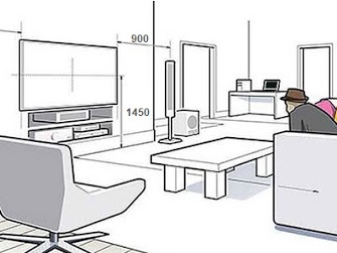
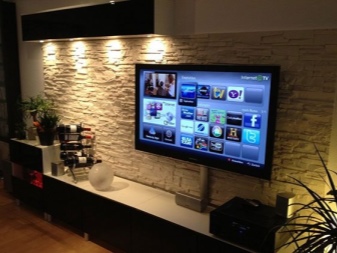
There are some nuances when placed in separate rooms. Living rooms or halls with sofas of classical height imply the installation of a TV at a level of 70 - 175 cm. But if the living room is decorated with a Japanese flavor, the installation height can be reduced to 10 - 15 cm. If there is no uniform style, and it is planned to invite guests with different heights, a movable bracket must be used. In the bedroom, you will have to pay attention to the dimensions of the room and to the location of the beds, to their height.
It should be borne in mind that TFT panels are especially sensitive to vertical placement. Low setting will increase the contrast, but the image will darken. If the device is placed high, the screen will be excessively highlighted. In both small and very large bedrooms, a very modern solution is placing the TV above the head of the bed. The situation is different in kitchens.
There it is necessary to take into account not only the installation height of the device, but also its location in relation to heat sources. Even the most reliable TVs will suffer from close proximity to stoves, sinks and radiators. If we are talking about a large kitchen-dining room, then you need to pay attention already to the distance from the dining area, and to the height of the furniture.
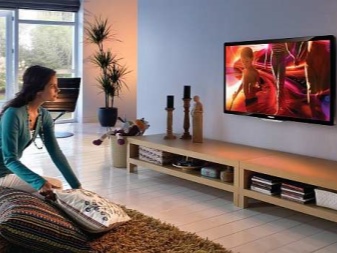
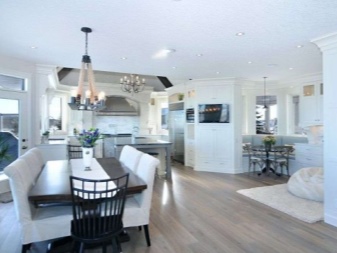
In any case, you will have to follow the general rules for orienting televisions in relation to viewers. And also avoid installing them where there will be strong light from the window.
In children's rooms, it is recommended to take into account the age and height of the children. But the factor of mobility also plays an important role. It is worth providing for a convenient overview from any point from where they can watch TV. Regardless of the room, there are strict rules:
- you can not throw your head back when viewing;
- the distance to the screen is the further, the larger the diagonal;
- the main viewing area should not be to the side of the desktop.
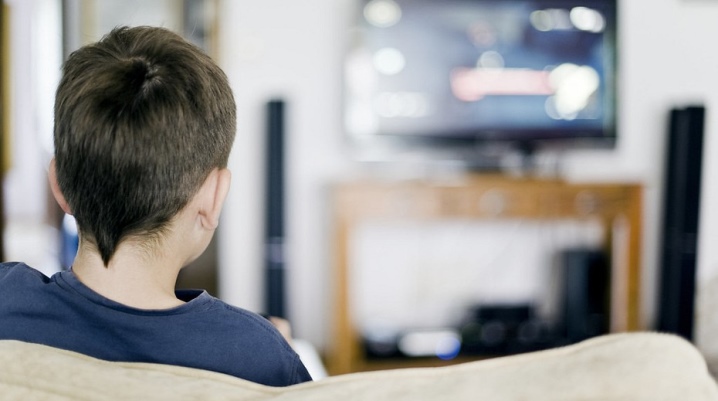
Optimal distance
Regardless of whether we are talking about a large flat panel or small CRT TV, the optimal distance should be 2 or 3 full diagonals. But it's also important to consider the resolution. The higher it is, the closer, all other things being equal, you can sit, ignoring individual points and providing a good view. In front of the bed or sofa, the distance should be at least:
- 1.9 m at 32 inches diagonal;
- 2.4 m at 40 inches;
- 2.8 m with a diagonal of 49 inches;
- 3.27 m @ 55 inches;
- 4.17m for a 70 '' TV.

How to choose a bracket?
The simplest mounts are designed exclusively for vertical suspension. More complex systems make it possible to tilt and twist the TV in the desired direction. A very important feature is the correspondence between the mass of the TV receiver and the load capacity of the bracket. But not complete, but with a margin of at least 20%. This will guarantee a long service life and increase resistance in situations where the load increases significantly.
Brackets are usually designed for specific diagonals. You just need to understand that if we are talking about the diagonal of a CRT TV, then a larger LCD screen can be hung on the same fixture. But the reverse replacement is, for obvious reasons, impossible.It is very important to ensure that the gaps between the standard TV mounts and the holes on the mounts match.
It is necessary to pay attention to both the VESA standard and the wall fixing area - the higher it is, the more serious the load can be.
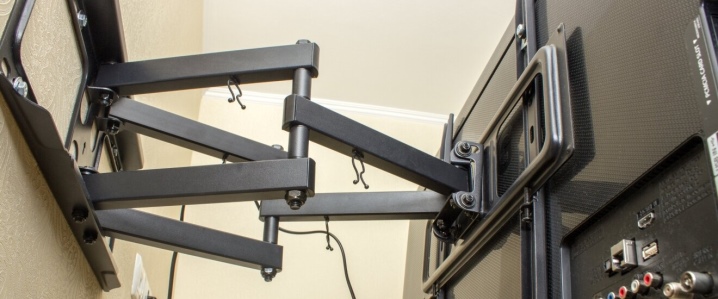
Even in the 2020s, CRT TVs have to be installed quite often. They require shelf brackets. Similar models are produced for modern slim devices. Pan and tilt functions are not necessary for all consumers, and for those who just want to keep abreast of news and weather reports, a simple fixed solution is enough. More complex supports are suitable mainly for moviegoers and other people who want to "squeeze" the maximum out of their technique.
In some cases, it also turns out to be important:
- external covering parts;
- circular rotation mode (useful if the TV is designed to display vertical pictures);
- remotely controlled electric drives;
- workmanship of the structure.
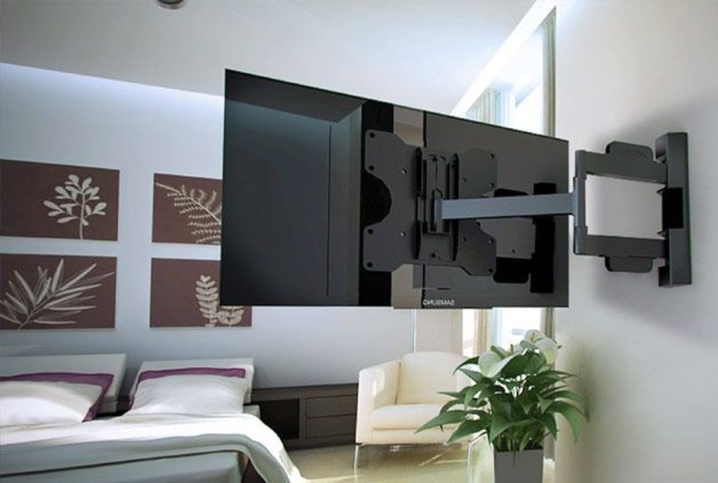
How to hang correctly?
Almost all mounts are designed so that you can install them yourself, and then hang a TV of a suitable size and weight, so you should not be afraid of this procedure. Typically two parts are used: one is mounted on the back of the TV and the other is mounted on the wall. Then you will need to dock them evenly using grooves or other parts. How to do this is exactly stated in the instructions. Universal brackets are set like this:
- connect the external unit to the panel using standard or exactly replacing bolts;
- mark the position of the device on the wall, controlling the line by level;
- note where the fasteners will be located (make sure that the brackets are placed close to the surface, and gaps would be excluded);
- additionally check everything by level;
- mark the attachment points;
- drill them;
- mount the wall part of the bracket;
- install the TV itself.
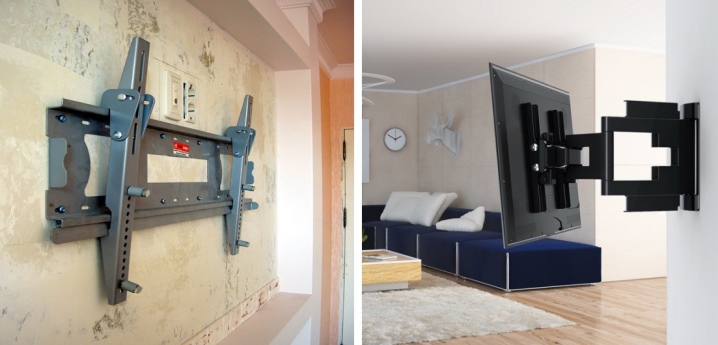
But the rules make it much easier to hang small flat-panel TVs. They will not require additional tools. On the back of the panel, grooves are provided. They are hooked with bolts pre-screwed into the wall. You just need to carefully measure everything and carefully calculate the required load.
However, this decision is best left as a last resort. A snug fit against the wall will prevent you from repositioning as needed. Ventilation problems may occur. You will not be able to hide the connection points and wires behind the TV.
The conclusion is obvious - if there are no required grooves or their use is not provided for by the instructions, it is better not to use such an installation scheme.
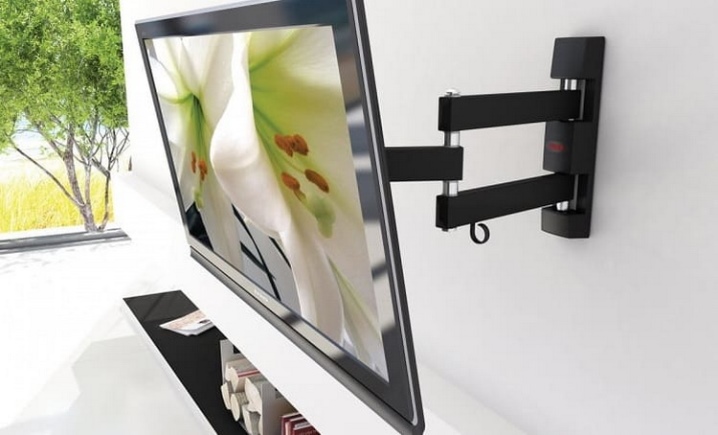
Installation nuances for different walls
Concrete
In this case, it almost does not matter whether we are talking about walls made of reinforced concrete blocks in a panel house or made of aerated concrete or foam concrete. In any case, it is very difficult to attach anything heavy to them, even if the wall is made of externally weighty foam blocks. Manufacturers of building materials do not guarantee that the installation will take place without problems. A good solution may be a special aerated concrete dowel, which has a special design. There are 2 options for it - metal or plastic; the metal type comes with wide spirals, and it also comes in the form of a sleeve, which is covered with teeth along its entire length.
A hole must be properly drilled under the dowel. It is passed through with a drill, which is 1 mm narrower than the dowel itself. In this case, the minimum diameter - 2 mm - must be strictly observed. On the puncher, you need to turn off the blow.
However, professionals advise not to resort to this method, but to use a drill.
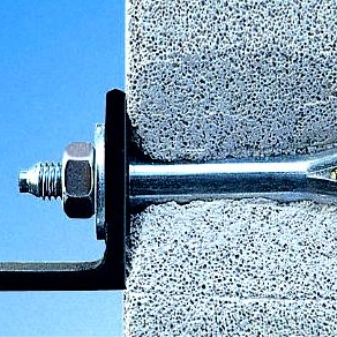

Drywall
Installation can be carried out on the partitions themselves. He is also sometimes led to special shelves or with the use of brackets.
Important: you should not mount equipment heavier than 30 kg. Basically, they install TVs on butterfly dowels.
Load-bearing elements are:
- anchors;
- steel tubes;
- channels;
- I-beam and other metal designed for certain loads.
Large-sized models will have to be strengthened. For this, a strong frame is created and a reinforced gypsum board is used. Plastic dowels cannot be used. Only self-tapping dowels should be used. The largest TVs are installed in arches or niches; an alternative could be through drywall to concrete or brick. If the distance between the drywall and the main wall is more than 10 cm, it is necessary to use embedded parts.
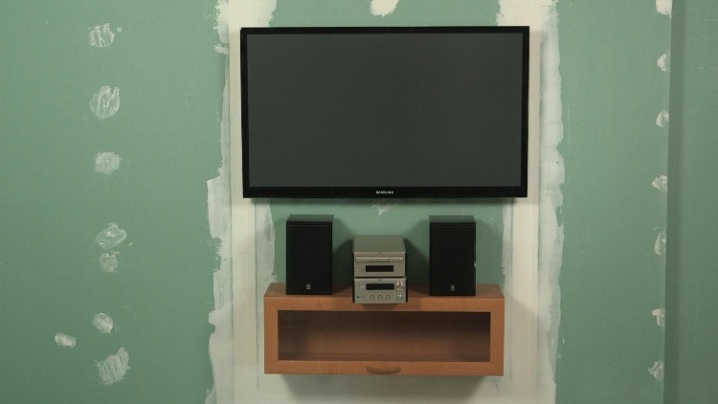
Wooden
In this case, you can use an already proven solution - a bracket. The connection to a thin wall is made with long bolts. Places for them are selected according to the traditional method. You can also use U-shaped profiles (they are easy to use, but this solution is not suitable for rooms with children or pets). Heavyweight TV models are mounted on pairs of square profiles.
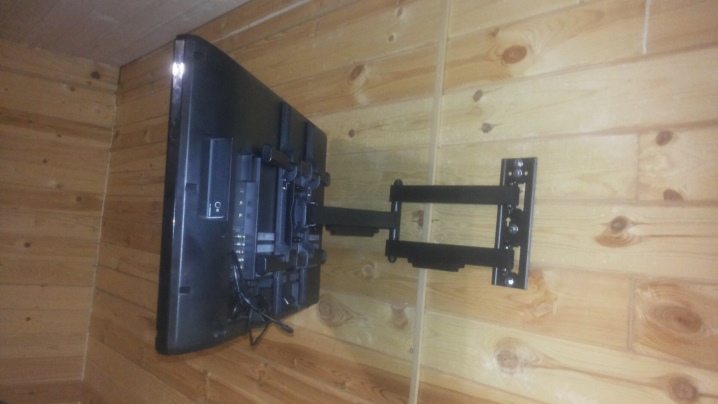
Of fragile materials
In this case, long bolts with wide washers are usually used. Aerated concrete partition is usually drilled through. Bolts through the holes on the opposite side are screwed in with nuts. It is advisable to mount a TV set on porous brick walls with chemical anchors. They are quite reliable and allow you to attach rather heavy things.
Sometimes it becomes necessary to hang the TV on the lining. Simple self-tapping screws are indispensable here. But reliable anchors with petals are very helpful. Among them, you should choose those that have the best pulling force. You can also pierce the material in other ways, ensuring a secure connection. Installation on a tongue-and-groove plate stands apart.
To install a heavy TV on it, an anchor with double sleeves must be used. You can also use universal plastic or expansion dowels.
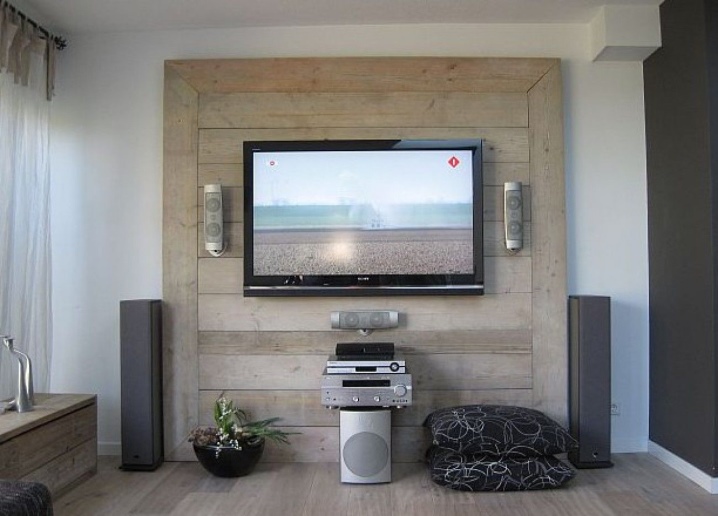
It should be borne in mind that fastening to the tongue and groove in ways that are optimal for thick concrete is not allowed. An amateur way of mounting - on "bugs". Alabaster is used to hold them, and therefore they work only with one hole at a time.
Recommendations
We must immediately think about whether we will acquire equipment with a larger diagonal in the future. Then you will have to use brackets and other fasteners designed for varying connecting dimensions and loads. The markup for editing can be done not only with a pencil, but also with a marker. When drilling, it is also advisable to use a dust collector, which will allow you to work more comfortably. If the bolts are too long, take several washers with them to ensure that everything is assembled properly.
Whenever possible, you should choose concrete or sturdy brick support pads. Only small TVs should be hung on drywall sheets. If you decide to mount TVs without a bracket, then you can use the standard furniture "ears". Installation is carried out as tightly as possible in order to save useful space (but without disturbing ventilation and problems with wiring). An alternative solution is to use 4 corners made of steel or aluminum.
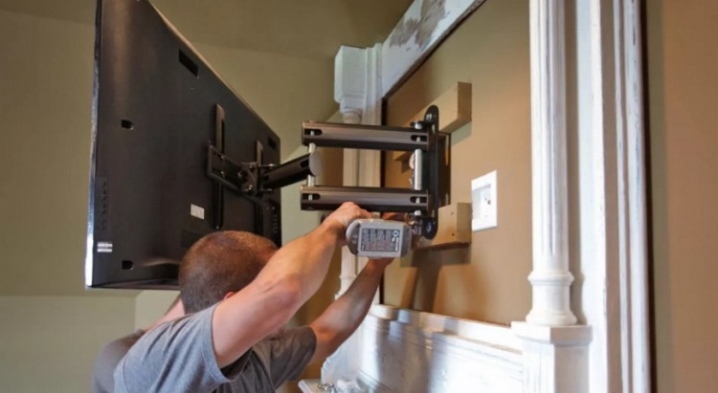
Beautiful examples in the interior
There are many solutions for placing your TV gracefully.
- One of these options is a simple TV with a black frame on a blue background. Symmetrical windows on both sides of the same wall will only enhance the experience.

- However, the TV set will look pretty also against the background of a bleached brick wall. Symmetry in this embodiment can be achieved with cabinets.
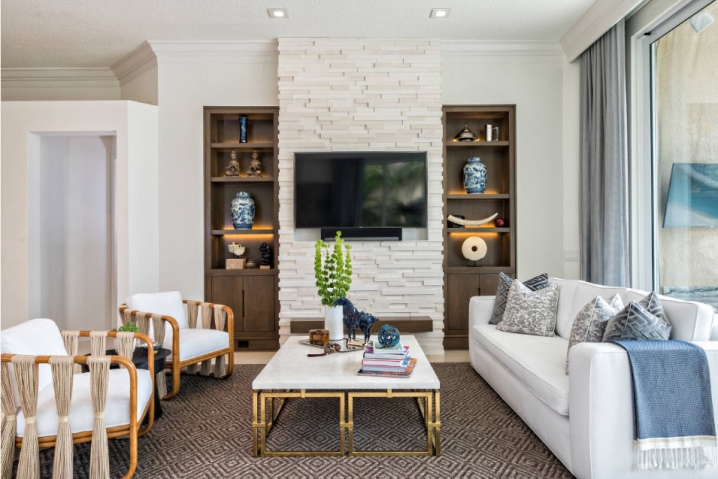
- However, this does not mean that there are no other ways to present the TV beautifully. It can look very attractive, for example, against the background of a rich crimson section of the wall. A plain white surface (classic) also comes in handy sometimes.

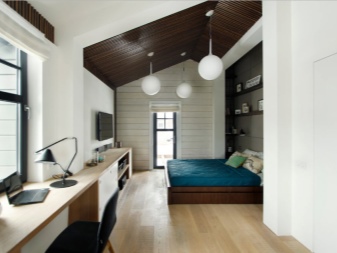
Other options might be:
- placement on a woody-yellow background (with bricks), surrounded by white walls and a plank floor, with an unusual chandelier;
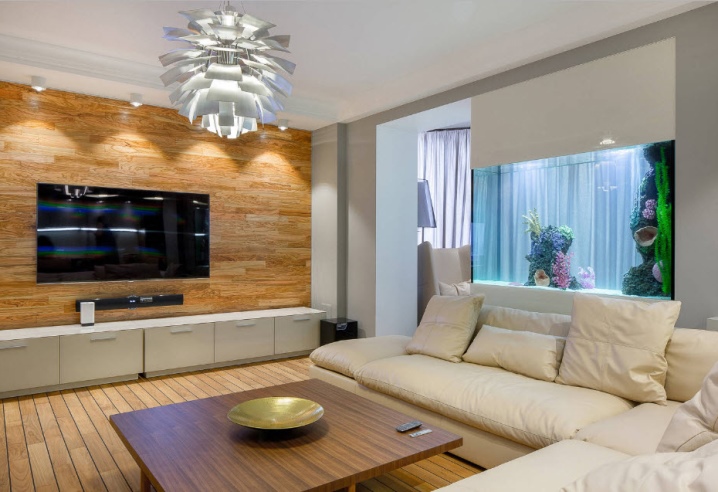
- installation on a panel attached to conventional log walls;
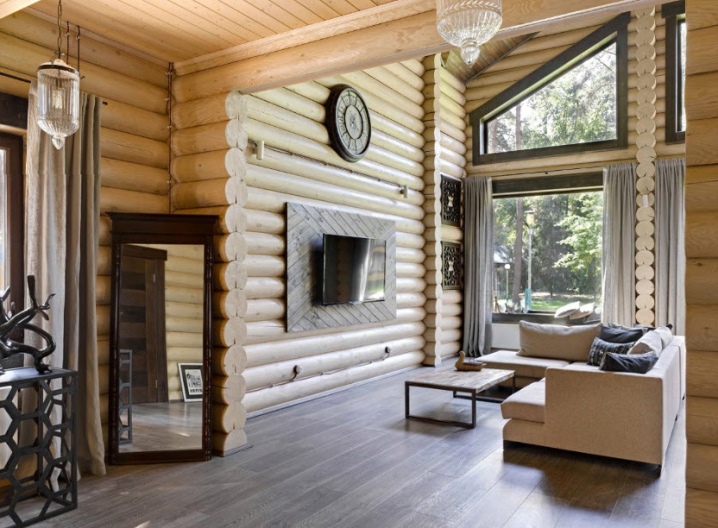
- a television set on a light yellow wall above the fireplace, surrounded by paintings;
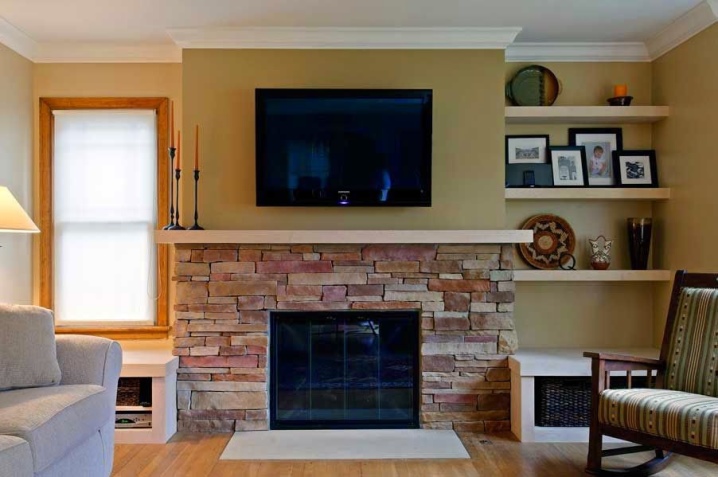
- another option above the fireplace on a simple light wall.
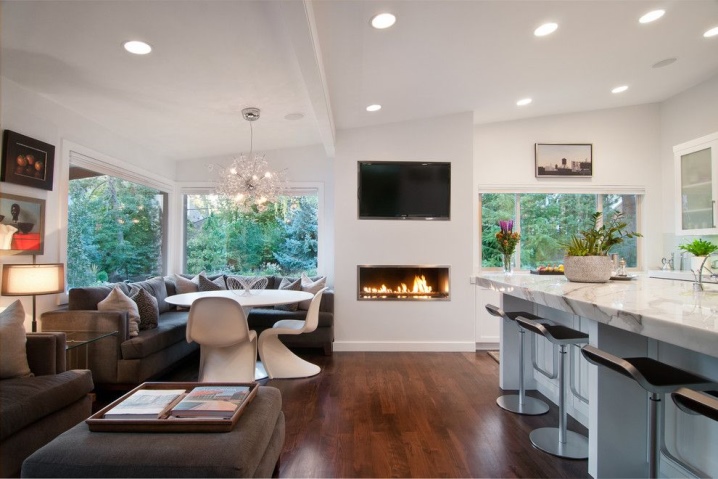
You can also look at other solutions, such as:
- TV on wall panels made of wood, plastic or leather;

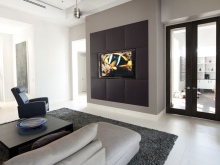
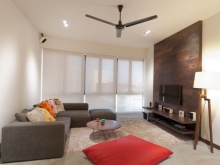
- leveling a dark discordant spot using an accent wall;
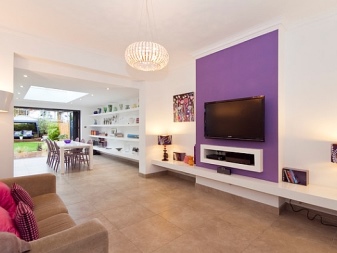

- encircling the TV receiver with pictures or photographs in thin frames;
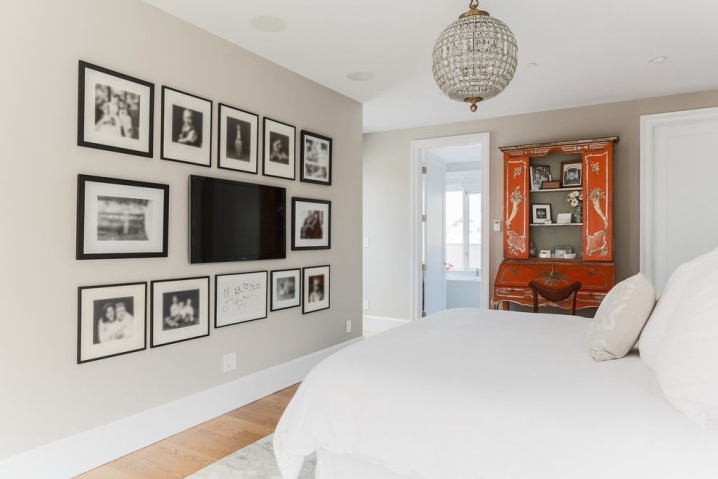
- the use of bas-reliefs;
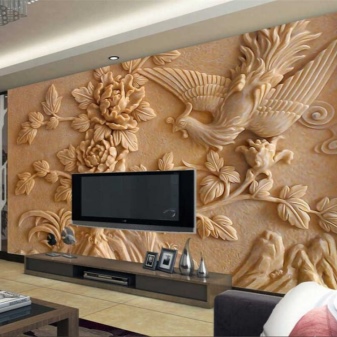
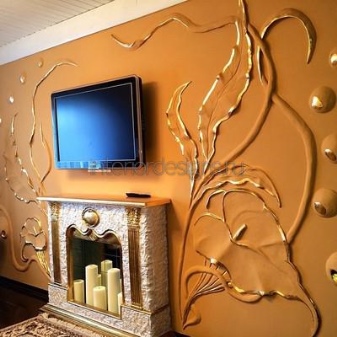
- connection of the plasma panel section with hanging shelves;
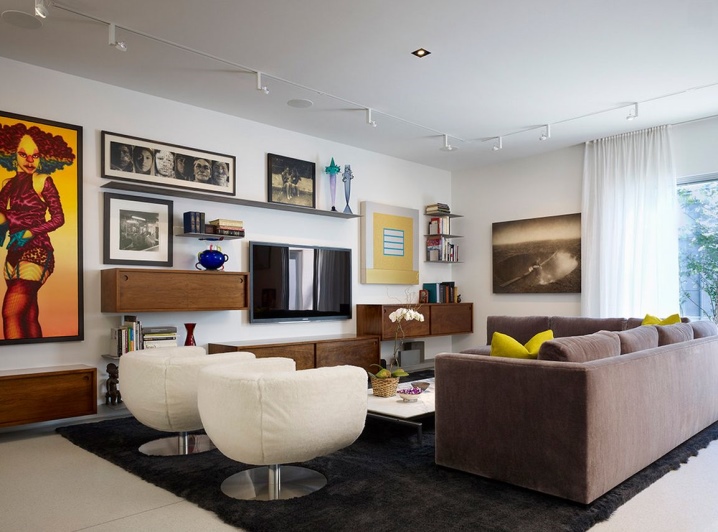
- installation in a plasterboard niche.
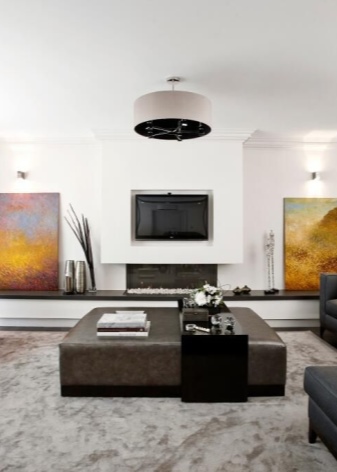
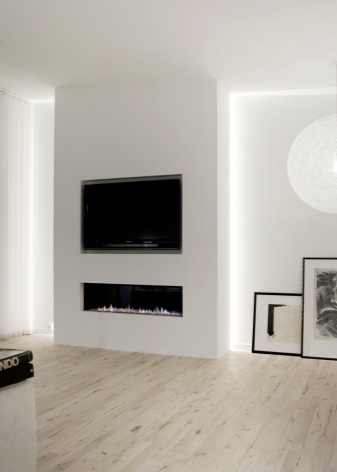
For information on how to hang a TV on the wall, see the next video.













The comment was sent successfully.